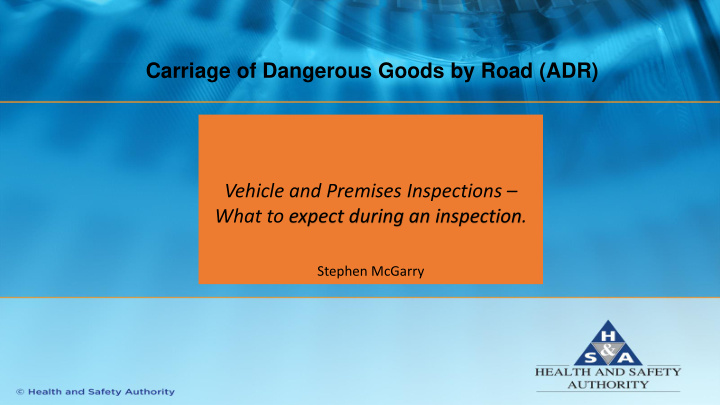



Carriage of Dangerous Goods by Road (ADR) Click to edit Master title style Vehicle and Premises Inspections – What to expect during an inspection. Stephen McGarry
Carriage of Dangerous Goods by Road - ADR Road side vehicle inspections • An Garda Siochana • Directive 95/50/EC as amended • Uniform checks in Member States • Dangerous goods vehicles and spot check on unmarked vehicles • 2018 247 dangerous goods vehicles inspected 147 non-dangerous goods vehicles
Vehicle Inspections • Vehicle stopped by Gardaí or HSA Inspector in the presence of the Gardaí • Inspector I.D. & purpose of inspection explained to driver • Duration – approximately 20 minutes • Driver required to provide information : - Documentation - Transport operation - Safety equipment on vehicle
Vehicle Inspection Documentation Common Problems • ADR Driver Training Certificate • Document(s) not carried • *Transport Document • Out of date • Instructions In Writing • Incomplete or incorrect information • Certificate of Approval for the Vehicle • Relevant authorisations e.g. No.2/2017 * Transport document must specify: - UN number, proper shipping name, class, packing group, (tunnel code). - Number and description of packages. - Total quantity of each different UN number - Consignor and consignee
Vehicle Inspection Transport Operation Driver may be asked to open the cargo holding area (vans, curtain-sided, freight containers) Inspection of: • Load security, • UN packaging, • Marking, labelling, over-packing provisions, • Packaging in test-date (IBCs) • Damaged or leaking packaging • Dangerous goods carried in line with documentation
Vehicle Marking and labelling • Vehicle orange plate marking • Vehicle placarding • Tank test data plate Occasional problems: - One or both orange plates not displayed - Placards/plates faded or damaged - Damage to tank shell
Vehicle inspection Equipment and PPE to be carried: Common problems: • Wheel chock • - Missing items…. Self standing warning signs (x2) • - Eye wash (2 x 500ml) Batteries flat • High visibility vest (torch /flashing warning • Torch signs ) • Suitable Gloves - Out of date eye wash or • Safety glasses when carried, out of date • For certain hazard classes (3, 4.1, 4.3, 8 and 9) filters for escape mask “spill kit” – shovel, drain seal, collecting - Extinguishers out of date container • Emergency escape mask (toxic substance/gas) (to be marked with next inspection due date). • Fire extinguishers (minimum x2)
Completion of vehicle inspection Driver handed inspection checklist, detailing; • location, date, time, carrier, consignor and load • the items inspected and infringements identified • Remarks if necessary and signed by the inspector - Follow- up action may include contacting the carrier and other participants - Enforcement action – written advice, Fixed Payment Notice, Contravention or Prohibition Notice….. Prosecution.
Premises Inspection Who?....Dangerous goods consignors, carriers, packers, (un) loaders, fillers, vehicle, tank, tank container or portable tank operators and dangerous goods waste producers. • Inspections unannounced • Senior manager/health and safety manager/DGSA • Duration 1 and 2 hours…. • Compliance - Visual inspection of plant and process, dangerous goods prepared for dispatch and any hazardous waste, supporting documents and training records. • 2018 – 210 dangerous goods premises inspections
Premises Inspection • Inspection may include the following: - Appointment of a Dangerous Goods Safety Adviser (DGSA), - Dangerous goods – produced, carried, used and hazardous waste products, - Packaging (specification and use), - Training / training records, - Documented procedures, - Tank files (tank history: vehicle approval certification and tank test records/ repair for each tank), - Exemptions ? (LQ, small load), - Accident reports, - DGSA annual report.
Premises Inspections Fundamental to all inspections - Is a DGSA appointed ? Mandatory for many organisations, but not all. Dependant on the activity involving dangerous goods; quantity, shipment frequency and tanks (tank vehicles/ containers/ portable) are used. If so, the DGSA annual report will be asked for. If not, a DGSA may still be required on an ad-hoc basis.
Premises Inspection • Premises inspection while checking for compliance is primarily advisory (report of inspection). • Ensure to ask the inspector if clarification is necessary. • Infringements must be addressed - follow-up action via a written report of inspection. • Further enforcement action, where necessary, may include the issue of a Fixed Payment Notice, Contravention Notice or Prohibition Notice. • Confirmation of compliance / action taken will be sought.
Vehicle and Premises Inspections Summary • Vehicle road side inspections are very prescriptive (uniform Checklist), report provided to driver, relatively short in duration – significant problems will lead to significant delays and further enforcement action. • Premises inspections afford a greater level of interaction between the participant and the inspector – take the opportunity to ask questions. • Majority of enforcement is advisory, primarily written (verbal direction may be given) and is legally binding on the participant.
Guidance available www.hsa.ie • Consolidated legislation S.I. 349, 2011 to 2017 • ADR Guide for Business • Guidance on the appointment of a DGSA • Guidance on the duties of a DGSA • ….. Many more
Recommend
More recommend